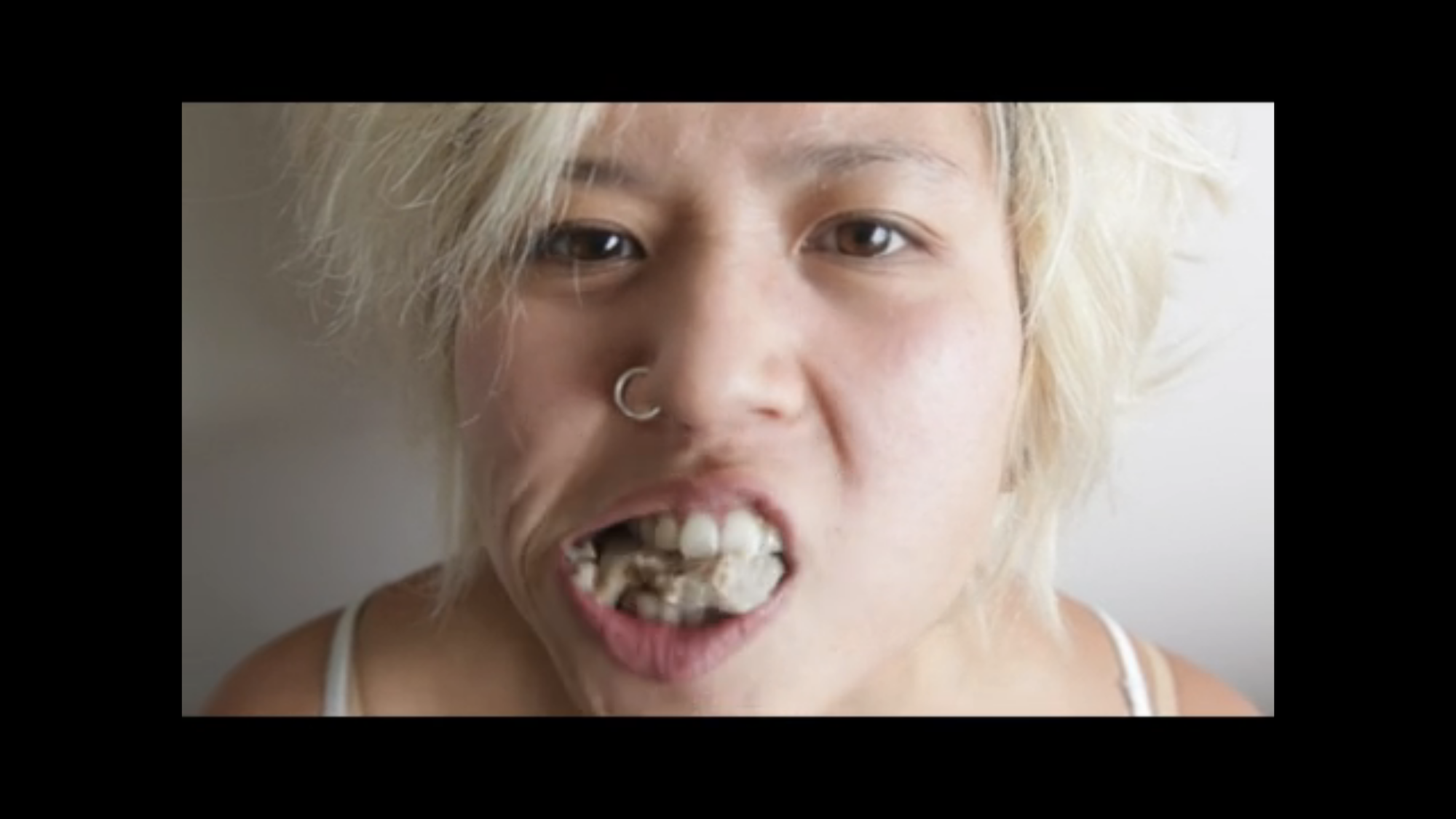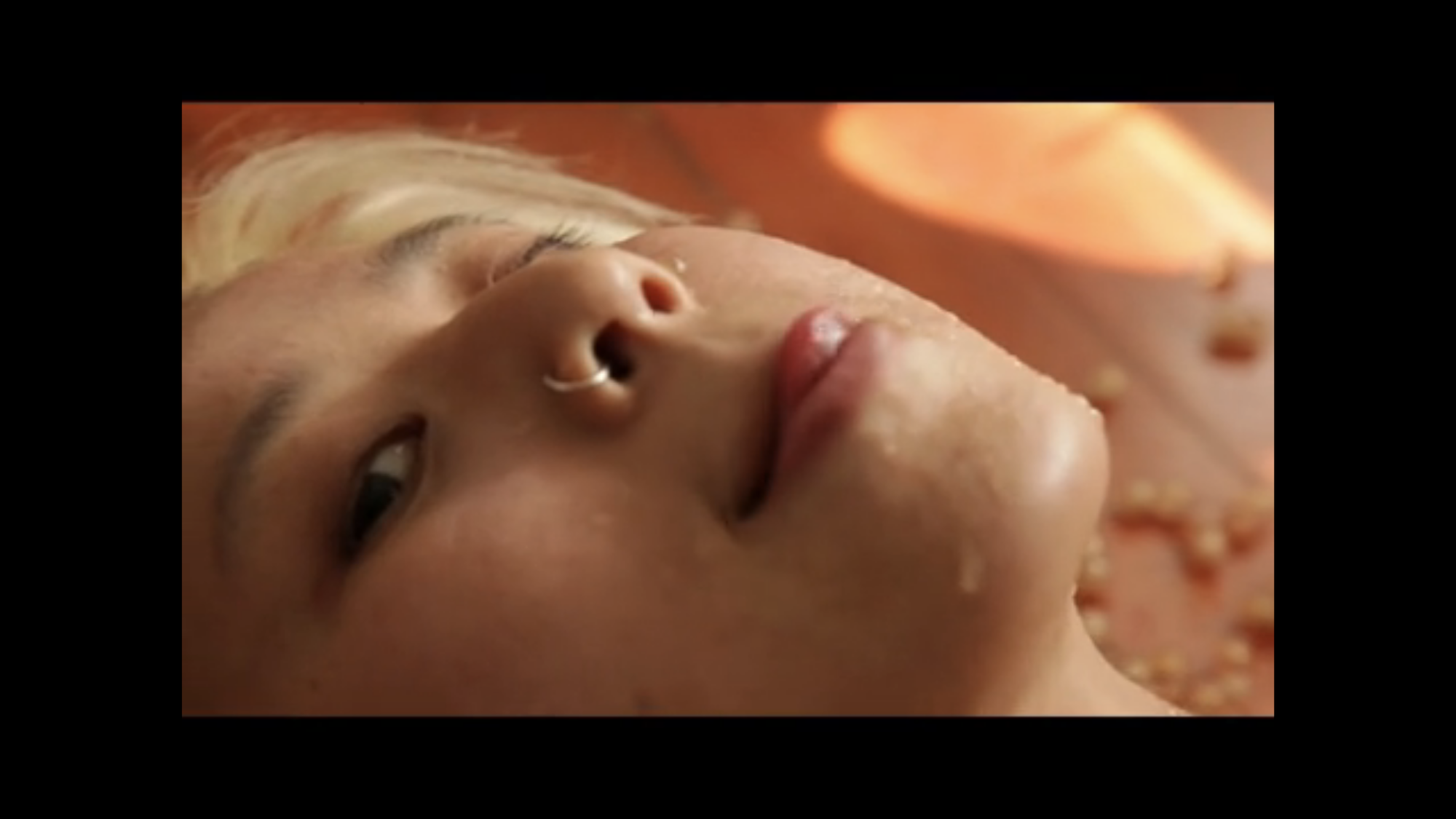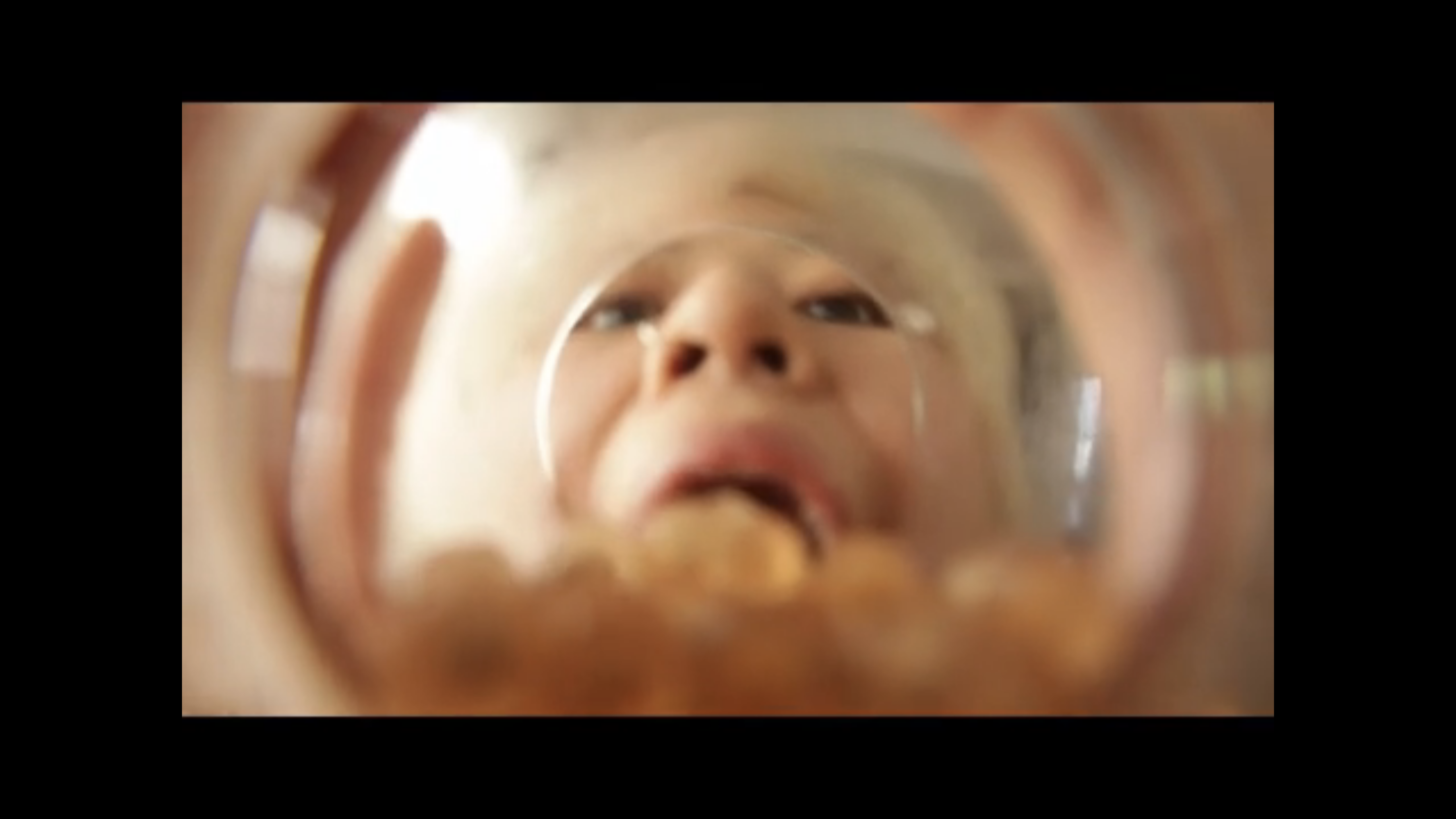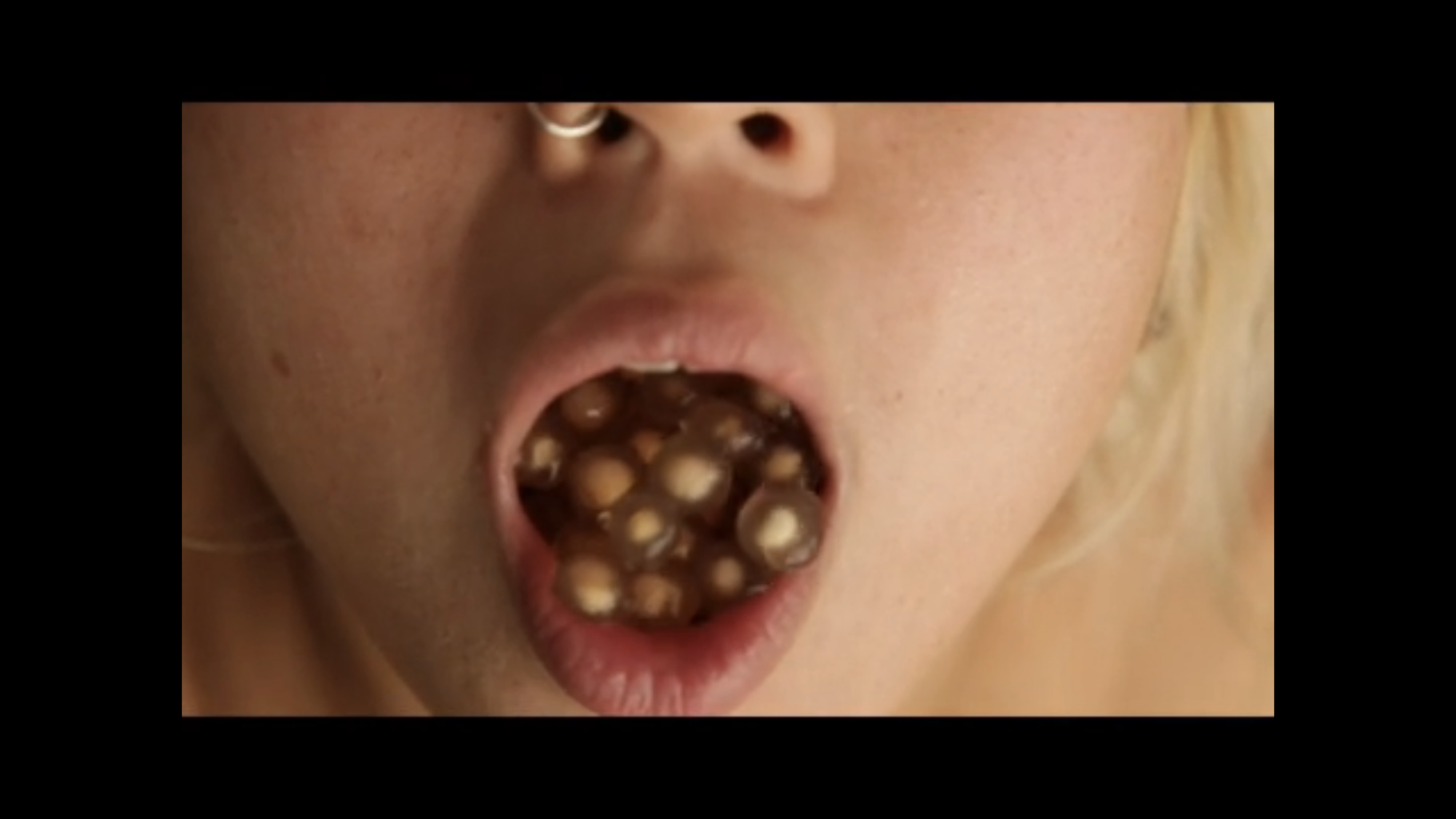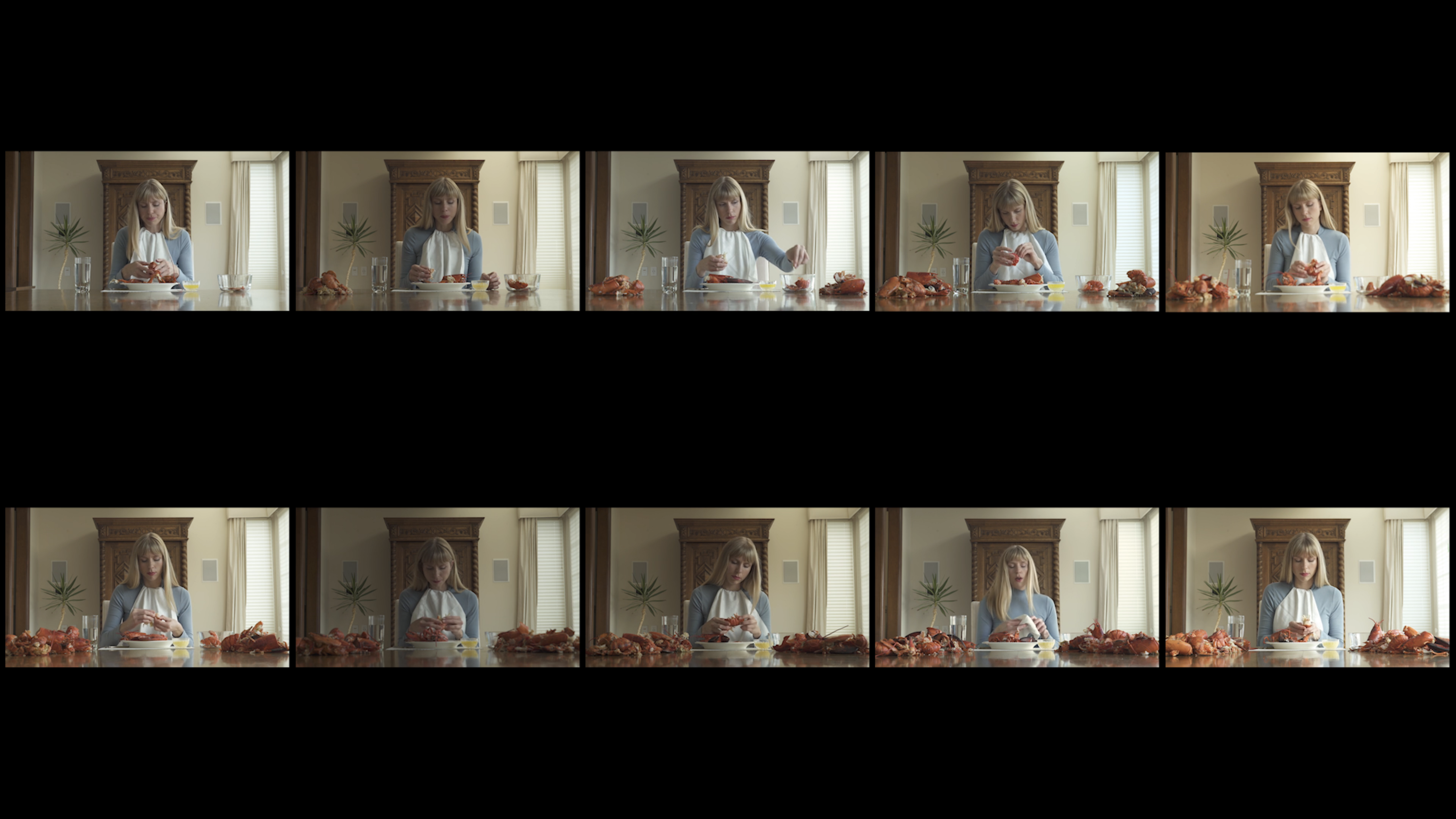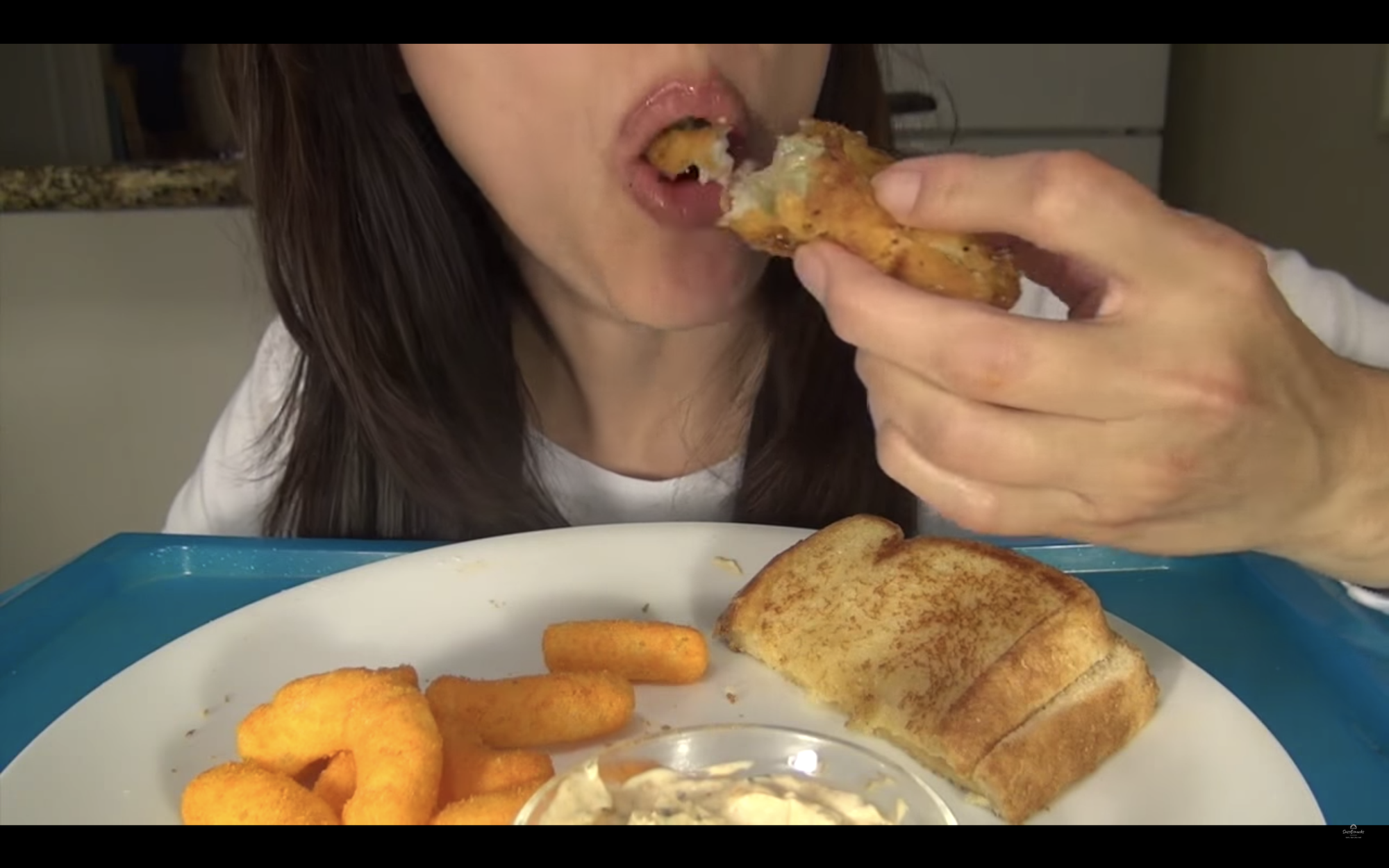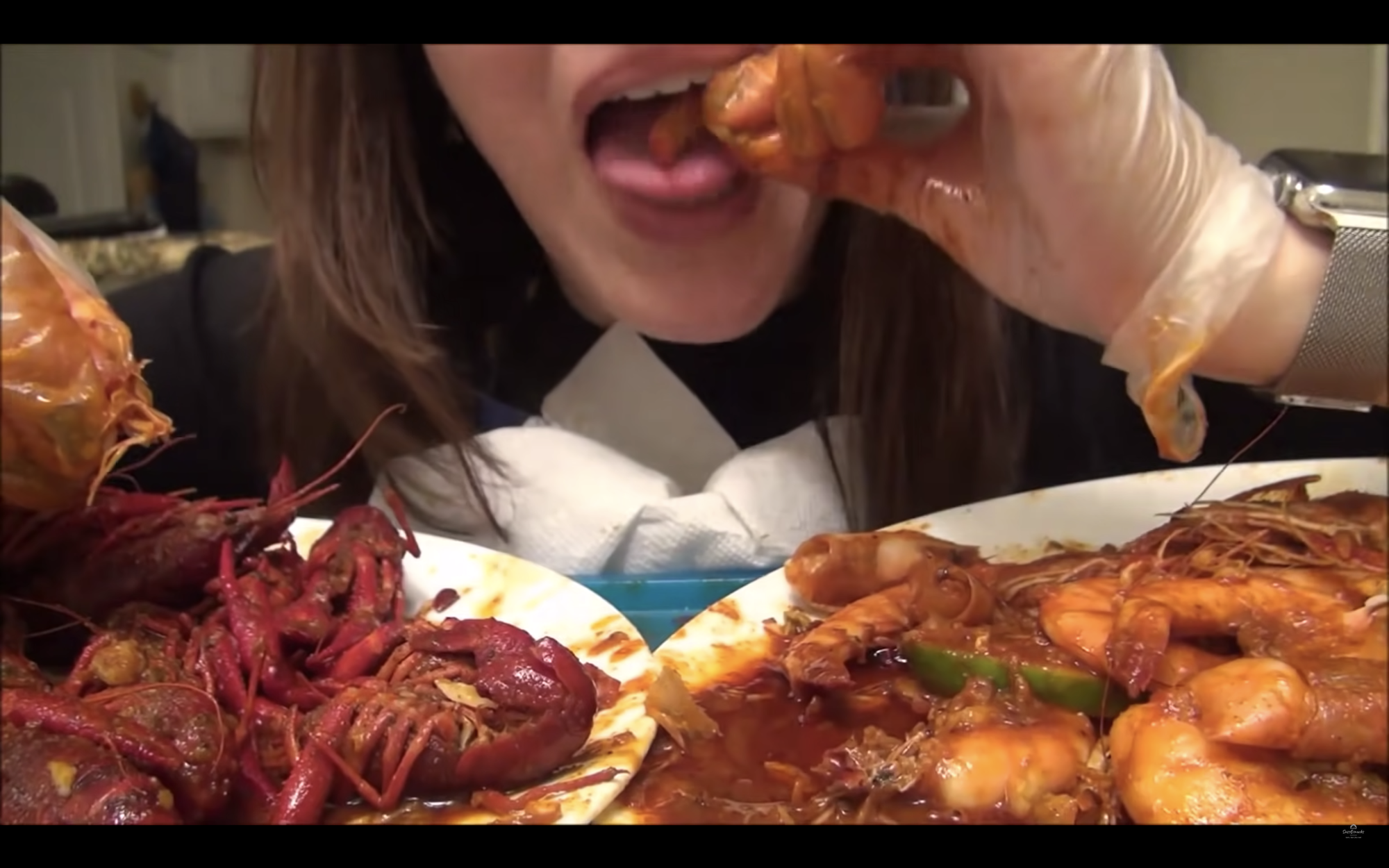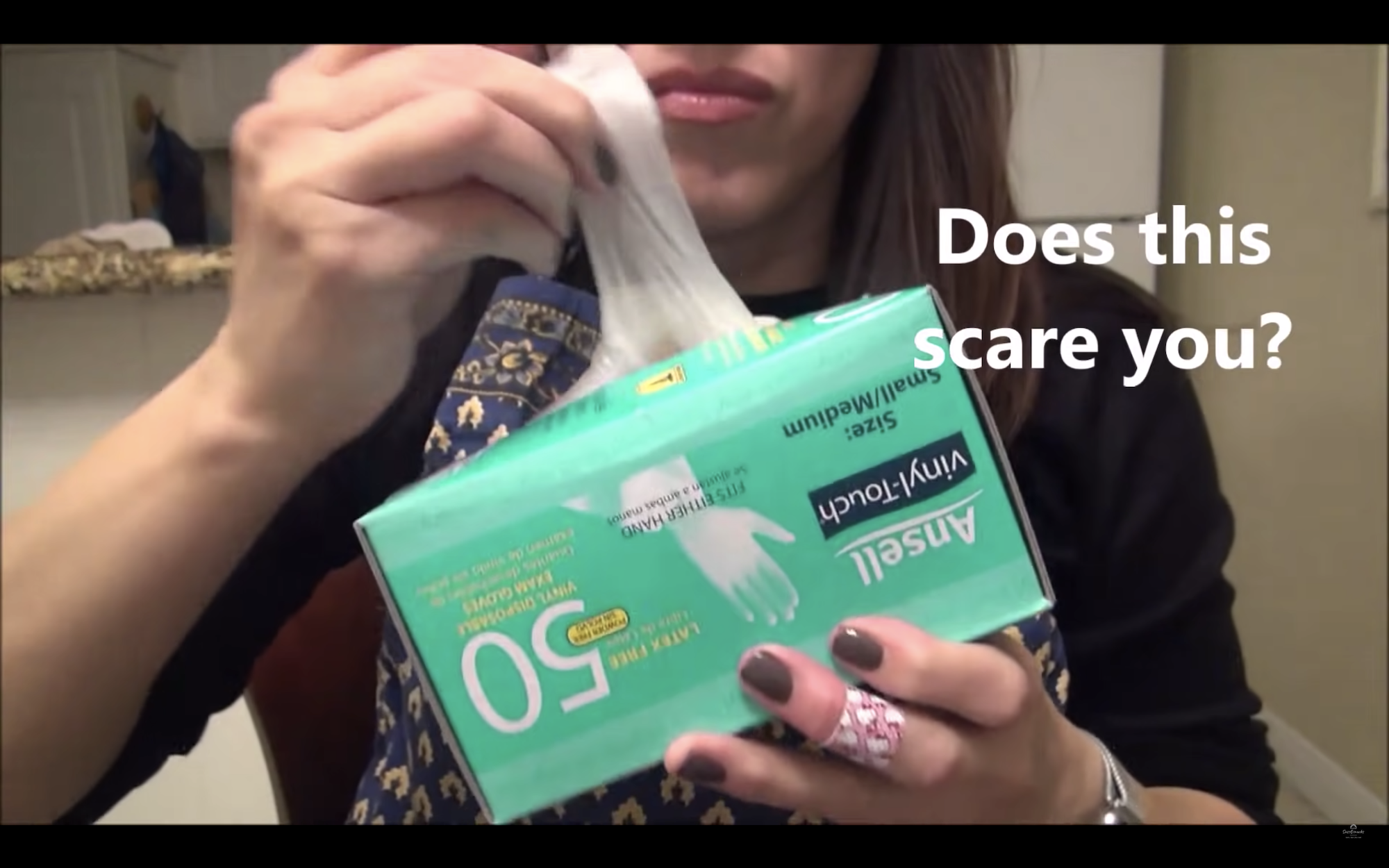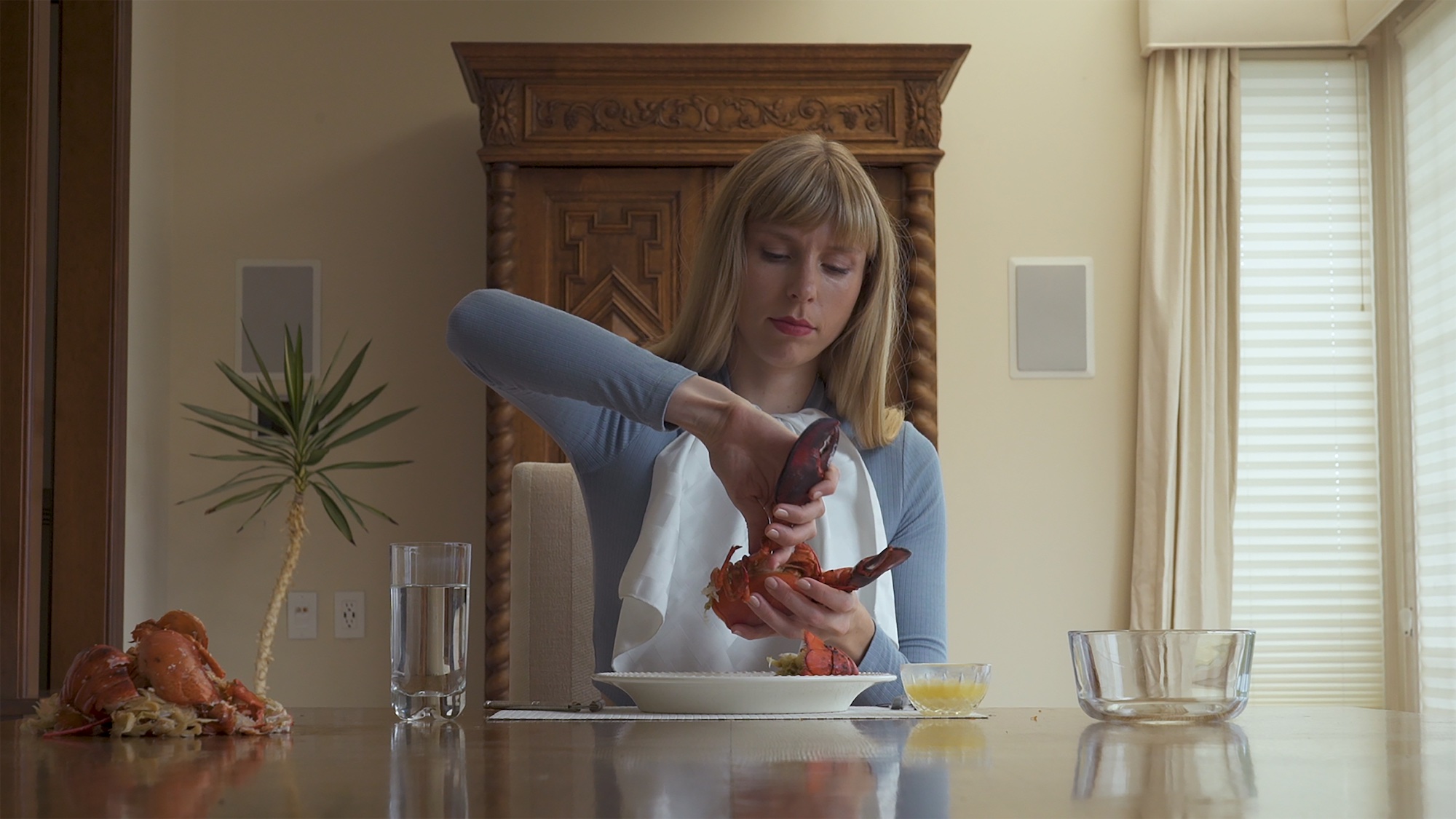
Laura Ohio, Les Petites Morts, 10 screen installation: performance videos play simultaneously [courtesy of the artist]
Binge Watch—On Performances of Excessive Eating
Share:
When I was 14, my grandmother gave me a copy of Looks by Madeleine George. This young adult novel describes the evolution of a friendship between two high schoolers: the “massive-sized” Meghan Ball and “stick-thin” Aimee Zorn. Even my undiscriminating teenage self knew the concept was over-simplified; it was practically Shallow Hal in book form. But I dutifully skimmed the first third of the book until I reached an unforgettable scene. After a painful encounter with Aimee, Meghan retreats to an old barn in the woods, where she proceeds to tear through two bags of popcorn, four candy bars, and boxes of Twinkies until “surrounded by the wreckage of the binge, eviscerated wrappers like the husks of dead insects all around her …. Meghan leans her head back against the barn wall and blacks out.”
Long after I finished Looks, I would sometimes take the book off the shelf and turn to that passage. It was compulsive reading; I felt my throat closing each time Meghan chokes on a barely chewed Snickers. Looks was my contraband, though I was never discouraged from reading it, because I knew there was something wrong about my urge to keep revisiting Meghan’s binge. In addition to books, I would do the same with images, too. After my parents left the house, I would grab our Nan Goldin photo book and flip to her terrifying self-portrait, Nan One Month After Being Battered (1984). I also hid in my dresser drawer a copy of People magazine that featured a picture from The Exorcist that showed a bloodied Linda Blair with her head turned backward. With my bedroom door locked, I’d force myself to look at the picture for as long as I could stand it.
Obviously, each of these things was distinctly taboo—self-harm, domestic violence, satanic possession—topics we acknowledge but refrain from bringing into public discourse. Binging embodies shameful urges that we feel but often deny, such as gluttony and lust. The act of binging is one of abjection. It demonstrates the power of something inanimate, or no longer animate, over human beings—in this case, food. The abject manifests viscerally as squirming, belching, or vomiting. Such images threaten the common belief that eating is pleasurable, a notion that begins in infancy.
In her 2010 film Gastro Porno, artist Kim Ye performs “eating as a graphic act.” As the camera pans her face and mouth, Ye slowly examines balls of meat, a black “century” egg, and large translucent tapioca balls. An acoustic version of Britney Spears’ “Toxic” by Yael Naim plays. The four-minute video reaches a crescendo when Ye finally takes a bite, and the century egg bursts to release a creamy grayish yolk that slides down Ye’s chin. The momentum continues: a disembodied hand shoves meatballs into Ye’s mouth until she’s stuffed. Later she sticks out her tongue to reveal tapioca balls that create a honeycomb-like visual with ominous, dark holes. And then? Ye begins spitting everything out, all while maintaining her unwavering stare into the camera.
Although it may be the least explicit scene here, I find the end of Gastro Porno to be its most disturbing: Ye looks sideways at the camera, as she lies on a sun-soaked wooden floor with a mass of half-chewed tapioca balls in the background. Ye’s chin is covered with wetness, a mix of juice and saliva, and she stares up, into the camera, her mouth partly open. She licks her lips as if to savor the taste. The act is defiantly subversive. Ye toys with the shifting power dynamic between herself and the hand that (consensually) feeds her. But what makes the performance stunning is that she appears to have enjoyed it.
Kim Ye, Gastro Porno, 2010, single-channel video, 4 min 11 sec, [courtesy of the artist]
Kim Ye, Gastro Porno, 2010, single-channel video, 4 min 11 sec, [courtesy of the artist]
Kim Ye, Gastro Porno, 2010, single-channel video, 4 min 11 sec, [courtesy of the artist]
Ye’s work generates abjection through her eroticized consumption of foods that could incite disgust. This act breaks down traditional meanings attached to eating—if eating is not for pleasure or sustenance, what is it for? Viewers might struggle to identify what they are seeing and, often, such confusion can spark feelings of revulsion. I feel startled by the look of pleasure on Ye’s face because I can’t understand how this “meal” could yield a positive sensation. I expect her to feel shame, to avert her eyes from the camera. Instead, Ye smiles like the Cheshire Cat after she exerts a gale-force blast of libidinal energy that I could only dream of replicating.
Kim Ye, Gastro Porno, 2010, single-channel video, 4 min 11 sec, [courtesy of the artist]
The abjection in Ye’s videos is made stronger by her play upon qualities of women that have been socialized as “foul.” In Powers of Horror: An Essay on Abjection, psychoanalytic theorist Julia Kristeva writes, “Dietary abomination has thus a parallel—unless it be a foundation—in the abomination provoked by the fertilizable or fertile feminine body (menses, childbirth).” Women are conditioned to conceal their eating, much like the way they conceal their leaky bodies (menstruation). In Ye’s work, when she eats and then regurgitates her food, she exhibits a porousness that disrespects the boundary between food and the body. This fluidity challenges the separation that Kristeva describes as “the organization that is ‘clean and proper.’” Said simply: Ye challenges the normative order of what we know to be true, and, as a result, we feel uncomfortable.
Artist Laura Ohio toys with the delicate boundary between cleanliness and abject that Kristeva articulates. In her video work Les Petites Morts (2020), Ohio eats a lobster every day for 10 consecutive days. Seated in a dining room with all the trappings of an upper-middle-class home, Ohio tucks a white napkin into a pristine, light-blue turtleneck—a brave fashion choice, given the task at hand—and looks into the camera. “This is my first time eating lobster,” she says. Day two: “This is my second time eating lobster.” And so on. Ohio cracks the lobster open with her hands and dismembers it, then scours the limbs for meat. She proceeds to chew and suck with the occasional dip into a small glass bowl of butter. Each sitting is nearly identical to every other, with only the mounting pile of lobster shells on the table—Ohio allows them to accumulate there—to memorialize her progress.
Despite the repetitive nature of Les Petites Morts, Ohio’s performance vacillates between superlatives. She’s restrained and ravenous, delicate and brutish. She never rests her elbows on the table, but she licks butter off her fingers between bites. According to Ohio, Les Petites Morts asks the viewer to “confront the dubious lines between voyeurism and exhibition, seduction and exploitation, performance and identity, privilege and commentary on privilege.” These tensions are the substance of the film, though they are disguised behind the monotony of Ohio’s procedural execution. Les Petites Morts can be watched and understood at face value—in fact, it falls squarely within the robust collection of YouTube videos wherein vloggers record their first time eating various food items. Although this reference might contextualize Les Petits Morts, it does little to mitigate the unsettling image of Ohio surrounded by piles of lobster remains. If anything, the dissonance between our expectation of the video (based upon YouTube genre as precedent) and the reality of Ohio’s performance only heightens the abject quality of the work.
Laura Ohio, Les Petites Morts, 10 screen installation: performance videos play simultaneously
[courtesy of the artist]
As with Gastro Porno, I gravitate toward the end of Les Petites Morts, when Ohio demurely stares down at her plate surrounded by nine lobster carcasses. The image is absurd: presented in this way, lobsters don’t suggest wealth or indulgence. The lobster, as a cultural symbol, is valuable in its scarcity. But in excess, lobsters are reduced to their creepy pincers and beady eyes, and we, as viewer (and eater), recognize our foolishness in ever believing the lobster could possess any meaning at all. Ohio is no longer indulging in a delicacy. Instead, she performs eating as a feat of endurance. Rewatching Les Petites Morts, I don’t see the beauty of Ohio’s dining room or her polished blond hair. Instead, I hear the crack of lobster tails, smell the foul scent of old shellfish, and see Ohio’s fingers digging into soft pink flesh.
A few months ago, I found a recipe in the New York Times Magazine for chocolate cherry cake. Writer Eric Kim dedicates the recipe to his late friend Lizzy, whom he met in the ASMR creator community. Lizzy’s YouTube channel, SassEsnacks, has almost 82 million views. Her videos are mostly the same: Lizzy eats a plate of food or a snack while whispering into a microphone. The camera frames her full lips as they smack and slurp down plates of black bean noodles, fried pickles, or Cajun crawfish.
SassEsnacks ASMR: Fried Pickles | Grilled Cheese Sandwich | Rap Chips Honeydew Crunchy Eating Sounds (screenshot) [courtesy of Youtube]
SassEsnacks ASMR: Cajun Crawfish/Crayfish/Mudbugs | Anniversary Video | Cooking | Mukbang | Whispers (screenshot) [courtesy of Youtube]
I decided to bake the cherry cake for a friend’s dinner party. I thought about Lizzy as I cooked, imagining how she would eat it—what sounds she would make. Lizzy, who passed away in 2019 from pancreatic cancer, is beloved on the internet. It’s not hard to understand why: She’s warm, attractive, and funny. But we’re also biologically conditioned to like Lizzy because she triggers ASMR (autonomous sensory meridian response) in our bodies. In other words, she exploits those qualities of her videos that provoke positive physical sensations in the brain of the viewer. We respond to Lizzy in ways we cannot consciously perceive or control.
Since Lizzy’s death, her family has taken over her YouTube account. They’ve posted links on her videos to resources for identifying early signs of pancreatic cancer. In the comments section, viewers leave notes about how Lizzy was a virtual fixture in their world. “I still can’t believe you’re not with us anymore,” reads one post. Another: “My first asmrtist I have watched on YouTube. You’re the queen.”
I felt compelled to mourn alongside Lizzy’s many fans as I watched videos of her shoveling food into her mouth. I scanned the exposed bottom half of her face for symptoms. Pancreatic cancer is often silent. Could we have known she was sick? Again, I turned to Kristeva for help in understanding: “Through oral-dietary satisfaction, there emerges, beyond it, a lust for swallowing up the other, while the fear of impure nourishment is revealed as deathly drive to devour the other.” We consumed Lizzy’s videos to feel some form of virtual fullness. In doing so, did we devour Lizzy, too? In regard to Lizzy’s suffering, were we complicit or complacent?
SassEsnacks ASMR: Cajun Crawfish/Crayfish/Mudbugs | Anniversary Video | Cooking | Mukbang | Whispers (screenshot) [courtesy of Youtube]
The word “binge” comes up frequently when we talk about our television watching habits. I binged Lizzy’s videos in rapid succession, feeling relaxed by her soothing voice and chewing noises. However, I also felt relieved at the end of the videos, when Lizzy would put her plate away and announce that she was full. Lizzy performed eating “correctly,” especially in comparison to Ohio and Ye. She had control over her food. I, however, couldn’t get enough. I kept clicking, wanting to vicariously taste Lizzy’s chocolate cake and take a bite of her heaping plate of poutine. In this virtual space, I ate and ate and ate.
I closed my laptop and felt sickened by the amount of content ingested, and by the amount of time I felt I’d wasted. But this sensation wasn’t in response to Lizzy’s videos alone. I felt this way after watching Ohio and Ye, too. The shame of binging transferred to the shame of watching binging. I realized my disgust was not with these artists’ performances but with myself. I had indulged a curiosity and desire that I could not safely identify. And who was to blame?
Lydia Horne is a journalist and artist living in Los Angeles. She’s the Director of Research and Editorial Operations at Alta Journal, and writes for outlets including Racquet Magazine and Hyperallergic. In May 2022, Horne received her MFA in photography from California Institute of the Arts where she began her practice re-presenting surveillance footage using fabric and video. She recently exhibited work at Helen J Gallery and Lois Lambert Gallery in Los Angeles. Horne formerly worked at WIRED magazine in San Francisco.
